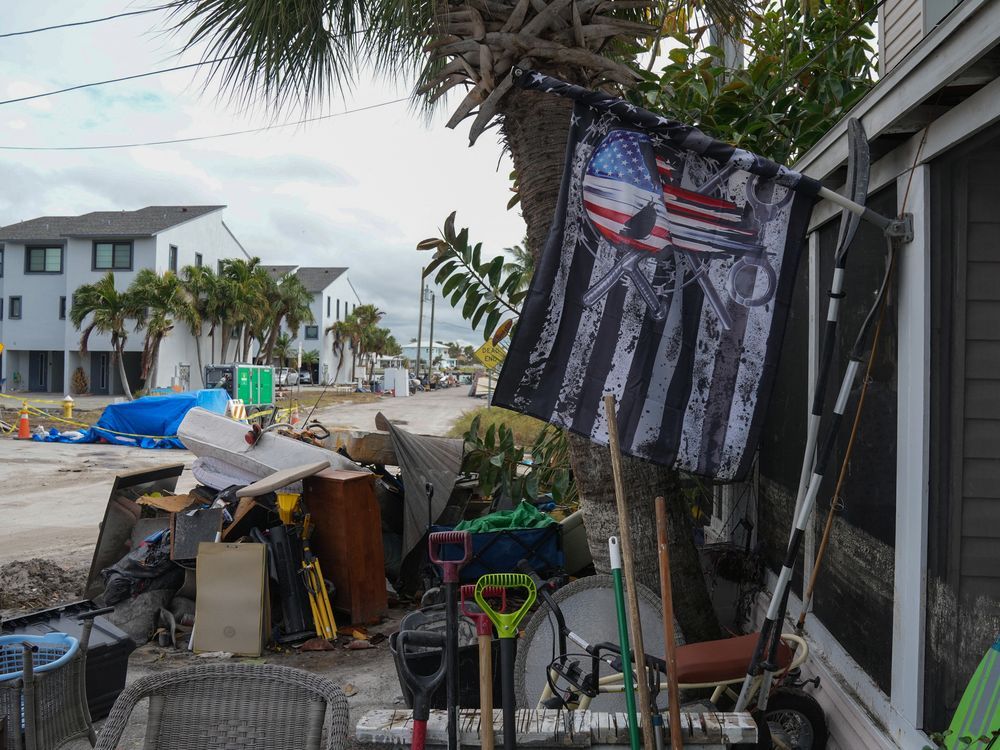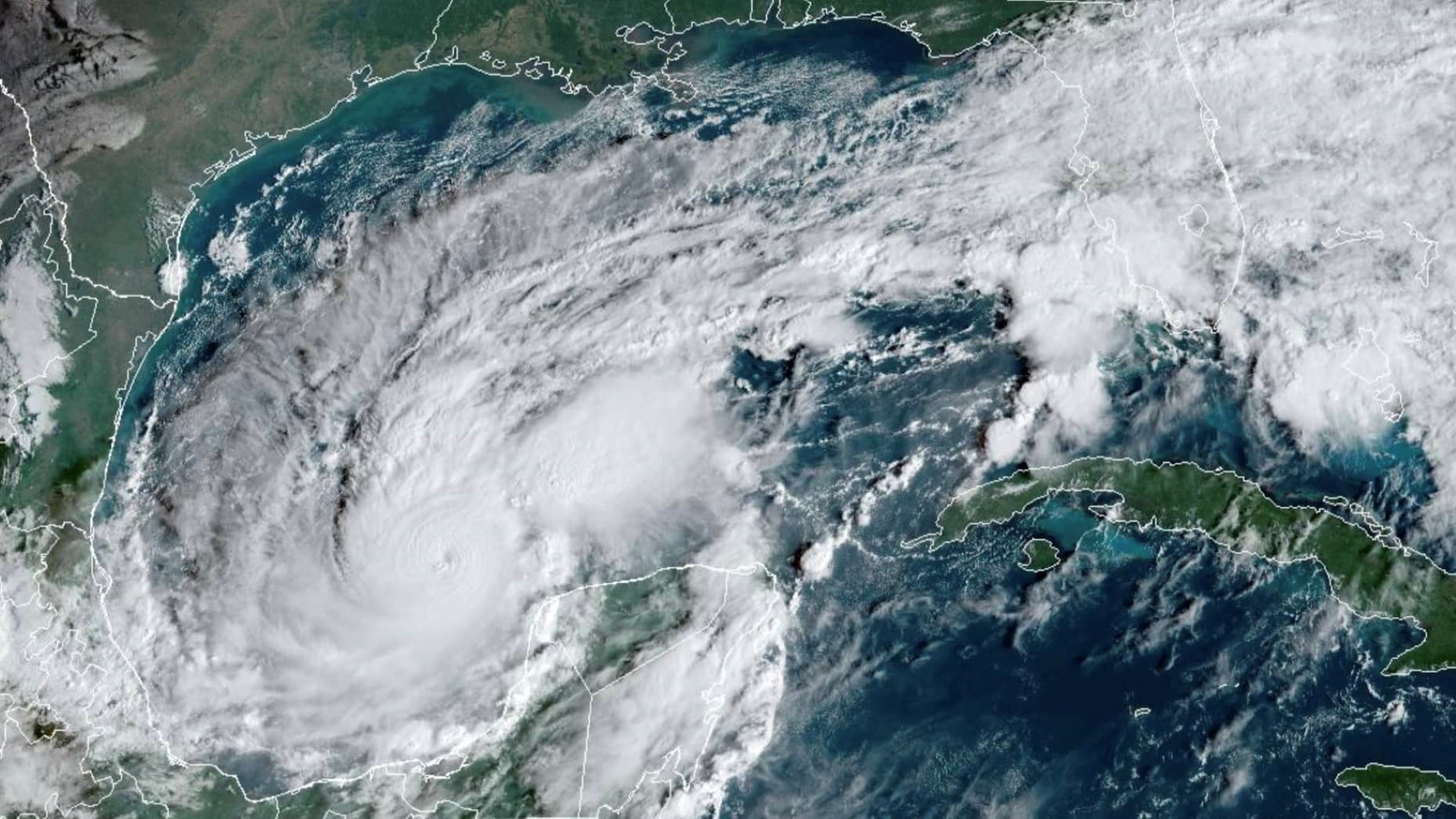~Florida Governor Ron DeSantis orders evacuations as forecasters warn center of storm could come ashore on Wednesday in Tampa Bay region.
Milton surged on Monday into a monster Category 5 storm with 180mph (290km/h) winds in the Gulf of Mexico, and is forecast to remain a dangerous major hurricane ahead of landfall on Florida’s Gulf coast.
“Milton is a potentially catastrophic Category 5 hurricane on the Saffir-Simpson Hurricane Wind Scale,” the National Hurricane Centre (NHC) warned in an advisory, noting it had “explosively” intensified. “While fluctuations in intensity are expected, Milton is expected to remain an extremely dangerous hurricane through its landfall in Florida.” Sitting amid the warm waters of the Gulf of Mexico with low wind shear, Milton is located 700 miles (1,126km) southwest of Tampa and 105 miles west-northwest of Progresso, Mexico, moving east at 9mph (14.4km/h) north of the Yucatan peninsula.
 Debris left by Hurricane Helene is piled up in the street in front of homes ahead of Hurricane Milton’s expected landfall in the middle of this week in Treasure Island, Florida on October 7, 2024.
Debris left by Hurricane Helene is piled up in the street in front of homes ahead of Hurricane Milton’s expected landfall in the middle of this week in Treasure Island, Florida on October 7, 2024.
“All folks on the west coast of the Florida peninsula should be prepared for potential major impacts,” said Florida Governor Ron DeSantis. He warned that the storm has been exceeding the predictions so far and told residents to stay vigilant.
The Tampa Bay area has not faced a direct hit from a major hurricane in over a century. While scientists expect a slight weakening before landfall, Milton could still maintain hurricane strength as it moves across central Florida toward the Atlantic Ocean. This trajectory would largely spare other states recently devastated by Hurricane Helene, which killed at least 230 people on its path from Florida to the Appalachian Mountains.
 An American flag sits in floodwaters in the aftermath of Hurricane Helene in the Shore Acres neighborhood Friday, Sept. 27, 2024, in St. Petersburg, Fla.
An American flag sits in floodwaters in the aftermath of Hurricane Helene in the Shore Acres neighborhood Friday, Sept. 27, 2024, in St. Petersburg, Fla.
DeSantis said it was imperative that debris from Helene be cleared ahead of Milton’s arrival so the pieces cannot become projectiles.
Forecasters warned of a possible 8 to 12 feet storm surge (2.4 to 3.6 meters) in Tampa Bay and widespread flooding from 5 to 10 inches (13 to 25cm) of rain in mainland Florida and the Keys, with isolated areas receiving up to 15 inches (38cm). The Tampa metropolitan area, home to over 3.2 million people, is at risk.
Much of Florida’s west coast was under hurricane and storm surge watches. Florida’s Lake Okeechobee, which often floods during intense storms, was also under a hurricane watch. A hurricane warning was also issued for parts of Mexico’s Yucatan state, which was expected to get sideswiped. The Tampa Bay area is still rebounding from Helene and its powerful surge. Twelve people died there, with the worst damage along a string of barrier islands from St Petersburg to Clearwater.
 Florida Gov. DeSantis cautions residents as Hurricane Milton gains strength.
Florida Gov. DeSantis cautions residents as Hurricane Milton gains strength.
In the race to clear away the aftermath from Helene, more than 300 vehicles gathered debris on Sunday but were blocked by a locked landfill gate when they tried to drop it off. State troopers used a rope tied to a pickup truck to force it open, DeSantis said.
Lifeguards in Pinellas County, on the peninsula that forms Tampa Bay, removed beach chairs and other items that could take flight in strong winds. Elsewhere, cookers, chairs, refrigerators and kitchen tables waited in heaps to be picked up.
Sarah Steslicki, who lives in Belleair Beach, said she was frustrated more debris had not been collected sooner.
“If this one does hit, it’s going to be flying missiles. Stuff’s going to be floating and flying in the air,” Steslicki said.
Hillsborough County, which includes Tampa, issued evacuation orders for areas near Tampa Bay and for all mobile and manufactured homes, effective by Tuesday night.
US President Joe Biden on Monday approved an emergency declaration for Florida, and congresswoman Kathy Castor said 7,000 federal staff were ready to help out in one of the largest mobilizations of federal workers in history.
 Milton has rapidly strengthened in the Gulf of Mexico, becoming a Category 5 storm Monday on a path toward Florida.
Milton has rapidly strengthened in the Gulf of Mexico, becoming a Category 5 storm Monday on a path toward Florida.
Milton’s approach brought back memories of 2017’s Hurricane Irma, when about 7 million people were urged to evacuate Florida in an exodus that jammed motorways and clogged petrol stations. Some people who left vowed never to evacuate again.
By Monday morning, several petrol stations in the Fort Myers and Tampa areas had already run out of fuel. However, fuel supplies continued to flow into Florida, with the state stockpiling hundreds of thousands of gallons of petrol and diesel, and more deliveries expected, according to DeSantis.
A steady stream of vehicles headed north towards the Florida Panhandle as residents heeded evacuation orders.
If residents do not evacuate, it could put first responders in jeopardy or make rescues impossible: “If you remain there, you could die, and my men and women could die trying to rescue you,” Hillsborough Fire Rescue Chief Jason Dougherty said.
 Milton exploded into the Atlantic’s strongest hurricane this year, bearing down as a catastrophic Category 5 storm on a Florida region still struggling to recover from Helene’s devastation.
Milton exploded into the Atlantic’s strongest hurricane this year, bearing down as a catastrophic Category 5 storm on a Florida region still struggling to recover from Helene’s devastation.
Milton’s wind speed increased by 92mph (148 kph) in just 24 hours – a pace that trails only those of Hurricane Wilma in 2005 and Hurricane Felix in 2007. One reason Milton strengthened so rapidly is its small “pinhole eye”, just like Wilma’s, said Colorado State University hurricane researcher Phil Klotzbach.
The storm is likely to go through what is called an “eye wall replacement cycle”, a natural process that forms a new eye and expands the storm in size but weakens its wind speeds, Klotzbach said.
The Gulf of Mexico is unusually warm right now, so “the fuel is just there”, and Milton probably went over an extra-warm eddy that helped goose it further, said University of Albany hurricane scientist Kristen Corbosiero.
The last hurricane to be a Category 5 at landfall on the mainland United States was Michael in 2018.
It has been two decades since so many storms crisscrossed Florida in such a short period of time. In 2004, an unprecedented five storms struck Florida within six weeks, including three hurricanes that pummeled central Florida. Other parts of Florida’s Gulf coast are still recovering from storms. The Fort Myers area in southwest Florida is still rebuilding from Hurricane Ian, which caused US$112 billion in damage in 2022. Three hurricanes have thrashed Florida’s Big Bend region in just 13 months, including Helene.




 Contractors with the City of New Port Richey help clean debris left by Hurricane Helene in preparation for Hurricane Milton on Monday, Oct. 7, 2024, in New Port Richey, Fla. (AP Photo/Mike Carlson)
Contractors with the City of New Port Richey help clean debris left by Hurricane Helene in preparation for Hurricane Milton on Monday, Oct. 7, 2024, in New Port Richey, Fla. (AP Photo/Mike Carlson)


